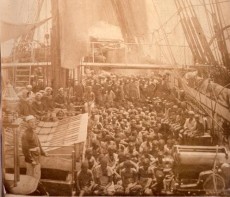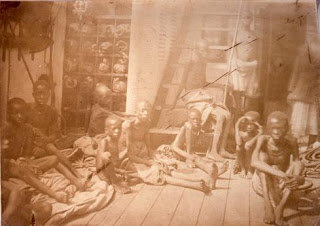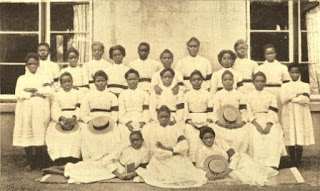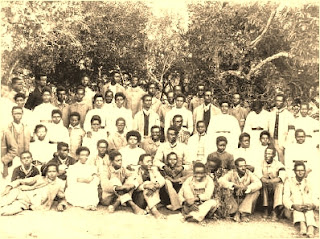In September 1888, some 204 boys and girls captured to be sold into slavery in Arabia from their homes in the highland area of the Oromia Region of Ethiopia got somewhat lucky when they rather found themselves in South Africa receiving an education.

Lovedale (rescued from slavery in the Red Sea)”
The Oromo slaves, as they were called, were aboard three dhows from Rahayta and Tadjoura on the Ethiopia coast when the HMS Osprey serving in the Royal Navy’s anti-slave trade mission in the Red Sea, based in Aden, intercepted them.
The children who spoke the Oromo language were bound for resale in Arabian markets. Other dhows with young human cargo were also apprehended.

Lovedale (rescued from slavery in the Red Sea)”
From their communities where they were apprehended, they had trekked as many as several hundred kilometres to the coast. The children were taken to Aden and, for a time, were housed and cared for at the Free Church of Scotland mission at Sheikh Othman.
On arrival, these boys and girls were often too debilitated to withstand the harsh climate and prevalent malaria. In 1890, 64 of the survivors were transferred to the Free Church of Scotland’s Lovedale Institution, in Alice, a town in South Africa’s Eastern Cape.

The story is captured in a new book laden with graphs, maps, charts and statistics. But if you like your history as narrative, you’ll have the job of piecing together this extraordinary story written by Sandra Rowoldt Shell in Children of Hope: The Odyssey of the Oromo Slaves from Ethiopia to South Africa.

For 10 years, these children were at Lovedale and proved to be good students. They were also in good terms with their Xhosa-speaking and English school mates. Four in five survived and left the school as young adults in search of opportunities. They became teachers, shop assistants, carpenters, painters, cooks, clerks.

Lovedale (rescued from slavery in the Red Sea)”
Many others stayed back in South Africa while 17 of them earned fares to return to their home in Ethiopia. A few married and started families.

Lovedale (rescued from slavery in the Red Sea)”
But most of the Oromo orphans’ lives ended in obscurity or tragedy. Mortality among the returnees was particularly high (33%).
However, the orphans’ stories are not completely lost. Many left behind their autobiographies at Lovedale. They narrated, in their own voices, their individual ordeals from the time they were captured, sold or pawned, including the tortuously long journeys between their Oromo homeland to the coast. All are rendered in full in the books’ appendices.

Lovedale (rescued from slavery in the Red Sea)”
Below are the names of the children who returned to Oromia in 1909 along with their origins produced by Diaspora Narratives.
· Aguchello Chabani
SON OF CHABANI AND GURDENFI – Taken from Enge by Black Arabs, district of Barsinge in Shan country. Enge was scattered on the slope of a mountain called Belchori.
· Agude Bulcha
SON OF BULCHA AND SANBATE – Taken from a village called Chonge In Macca Province (Wallaga district).
· Amanu Figgo
SON OF FIGGO AND ZAIDA – Taken from Agam, in the Urbarage country, the king of which was called Lallego.
· Baki Malaka
SON OF MALAKKA AND MUJA – Taken from what is believed to be Seka in Jimma.
· Berille Boko Grant
DAUGHTER OF BOKO AND TURUNGI – Taken from a village near Gibbe River
· Dinkitu Boensa
DAUGHTER OF BOENSA AND KURNI – Taken from a village called Garjeda in the Gindo country.
· Fayesse Gemo
DAUGHTER OF GEMO AND YARACHI – Taken from a village called Upa in the Kaffa country.
· Fayissa Umbe
SON OF UMBE AND ASSETI – Taken from a village called Mangera, in a country called Sayo.
· Galgal Dikko
SON OF DIKKO AND HUDO – Taken from a near Tibbe, West of Ambo.
· Galgalli Shangalla
She was taken so young that she did not remember names of her parents. Taken from Kilema, in the Shangalla country.
· Gamaches Garba
SON OF GARBA AND BADANI – Taken from a village called Kilerito, in a country called Liban, west of the river Abaye.
· Gutama Tarafo
SON OF TARAFO AND GURO – Taken from a village Gamoje, in the Gera country
· Hawe Sukute
DAUGHTER OF SUKUTE AND IBSE – From the village of Gani in the Garjeja country
· Liban Bultum (worked with Edwin Foot in the First Afaan Oromo to write English Dictionary)
Son of Bultum and Sumburi – Taken from Ilu country
· Nagaro Chali
SON OF CHALI AND – Taken from Deko in the Dappo country
· Nuro Chabse
SON OF CHABSE AND SHOKACHI – Taken from Bita in the Kaffa country.
· Rufo Gangilla
SON OF GANGILA AND JORBO – Taken near the village called Tosa, in the district of Gera, between Jimma and Kaffa.
· Tolassa Wayessa
SON OF WAYESSA AND HATATU – Taken from Jimma in the Tibbe country.










